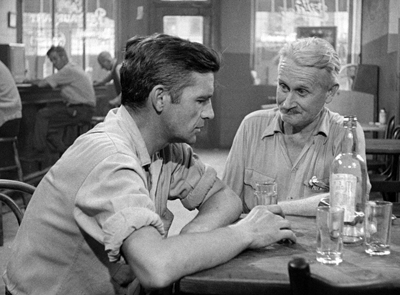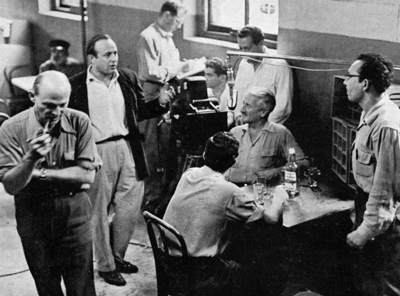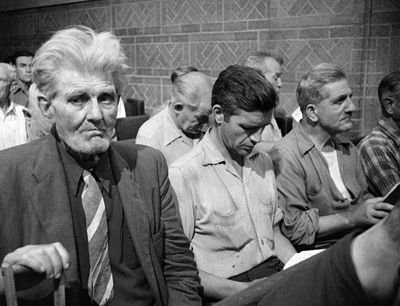
 |
|
|
|
Milestone Film has outdone themselves with their new Blu-ray of On the Bowery, a pioneering and wholly original independent effort that earned an Oscar nomination for Best Documentary of 1957. The picture has been claimed as a major inspiration by the greats of the American independent film, from documentarian Emile de Antonio to actor-turned director John Cassavetes. MIlestone's 2-Blu-ray set is officially The Films of Lionel Rogosin, Volume 1, and contains other contents just as impressive. 
In the 1950s many New York- based filmmakers talked about finding a more truthful path to cinematic virtuosity, but Rogosin was the man to show everyone the way. His On the Bowery takes us to a place where nobody wants to end up: skid row. Five minutes into the movie we're convinced that everything we see must be absolutely real, unrehearsed and unscripted. A few minutes later we realize that director Rogosin has somehow drawn performances from un-directable subjects, in a place where a camera crew would not possibly be tolerated -- the awful streets and miserable bars of The Bowery. This is one story about alcoholism not told in the Ken Burns documentary Prohibition. Today we have "homeless people", who were perhaps always with us but rendered invisible by the media. On the Bowery deals with the pathetic denizens of a couple of really vile city blocks in lower Manhattan. Chronic, advanced alcoholics mill about on the sidewalks. They live in filthy clothes and survive from drink to drink, scrounging money as they go along. Some of them apparently receive support from the outside, but we see others making "squeeze" from poisonous Sterno cooking fuel. If they have thirty cents they can sleep in a flophouse, and if they don't they collapse on the sidewalk. Many of these guys just get so wiped out that they fall down as soon as they exit the bars. 
There is a story of sorts. A fairly young fellow (30? 35?) named Ray (Ray Salyer) arrives fresh from a railroad job with a suitcase and some cash. He's soon chiseled and fleeced by Gorman (Gorman Hendricks), an elderly, sharp operator who befriends him and secretly steals his possessions. Gorman then arranges to play the hero by giving some of Ray's own cash back to him, as a gift. Ray finds a day's work unloading a truck, and almost joins a church mission that promises a clean room and food for those willing to cut out the booze. Ray instead goes on an even worse bender, and narrowly avoids being picked up in a police sweep. What makes On the Bowery so special? First, the excellent cinematography is on a quality level with high-grade ethnographic still photography. There is no grainy footage and none of the catch-as-catch-can handheld work that would become the standard when sync-sound 16mm cameras arrived several years later. Secondly, we can scarcely believe that anybody could get such candid, authentic, sync-sound footage of this subject. Some of the action on the streets may have been captured from hidden trucks but the scenes in the bars are phenomenal. These men are seriously inebriated. Many appear to have 'diminished capacities'; some may have been feeble-minded before they pickled themselves. Rogosin has these rummies participating in absolutely convincing conversations, leaning on each other for handouts and drinking, always drinking. It's like a peek into a world you couldn't see unless you were a participant, which gives a clue as to director Rogosin's technique. Many critics have commented on the film's parade of faces, which are both fascinating and frightening. We are confronted with dozens of brutalized faces in every minute of film. Some have clearly been beaten bloody. Plenty of guys have various kinds of injuries, perhaps suffered when under the influence. They're all so close up and authentically human. Each must have a story yet we wonder how many are in shape to carry on a real conversation. The denizens of the Bowery are like strange inhabitants of an existential asylum, living in plain sight but ignored (or mythologized) by society. 
On the Bowery is one of the few non-narrative films that generates the same interest as a good drama. Gorman claims that he's busted but has a semi-permanent "flop" he can call his own; he uses his congenial manner to steal but is human enough to need to be liked. His story about once being a doctor is so good, we almost believe it. In contrast Ray seems a sensible guy but is definitely addicted to the bottle. It's as if he just doesn't see any point to life beyond his next drink. Milestone has previously given us an entry into masterpieces by great independent filmmakers: Kent McKenzie (The Exiles ) and Charles Burnett (Killer of Sheep). These documentarians are all drawn to reveal aspects of the urban underclass in America. Rogosin's reputation is very much alive and the evidence presented in the The Films of Lionel Rogosin, Volume 1 can only enhance it. The first Blu-ray disc contains On The Bowery, which can be watched with an introduction by Martin Scorsese. The Perfect Team, a making-of docu by Rogosin's son Michael, answers many of the questions left open by the film itself. After experiencing WW2 Lionel Rogosin determined to use a camera to change society. He found that the only way to film in the Bowery was to spend months with the locals until he gained their friendship and trust. He and his cameraman were hard drinkers as well, and his two main actors were recruited from the street. Gorman Hendricks was on his last legs. He stayed sober (and alive) just long enough to finish the film. Rogosin believed that Kentucky man Ray Salyer had a future as an actor and claims that Ray had offers from Hollywood. We see Salyer appear on TV, cleaned up and in a suit, asserting that he likes to drink the way some men like to fish or play golf. His eventual response to the public spotlight was to hop a freight train out of town, and disappear forever. The first disc also contains a newer piece by Michael Rogosin called A Walk Through the Bowery, a 1972 docu (Bowery Men's Shelter), a 1933 newsreel (Street of Forgotten Men) and an On The Bowery trailer. Disc two contains films just as powerful. With the experience of On The Bowery under his belt Rogosin turned toward the bigger themes of war and inhumanity that were his original motivation. 1964's Good Times, Wonderful Times belies its title to make a direct assault on complacent attitudes toward war -- its causes, its effects, its importance. Rogosin invents a docu scripting strategy that was soon abused by others: ironic contrast. His framing device is an English cocktail party. We hear a non-stop litany of trivial talk and small-minded observations. A gaggle of male admirers congregate around a couple of "outgoing" young women that tease them with mild provocative talk. Some of the men are ex-soldiers. These party scenes are very convincing. Various pointed statements emerge -- that war builds character, that war is a natural thing, that it controls the world population like floods or disease. Quite regularly Rogosin cuts to film footage culled from film archives around the world: England, Japan, the Soviet Union. The footage is in mostly excellent condition, and when it isn't we're very aware that we're seeing 'rescued film' that somebody didn't want shown. Much of it is wholly unfamiliar, unseen in any war docu I've yet encountered. Rogosin starts with some disturbing scenes of Hiroshima bomb victims, including graphic shots censored from other docus. A cocktail party discussion asking, "who permits wars to take place?" is followed by segments devoted to the utter worship granted Adolf Hitler by the German citizenry. Admiring throngs throw flowers in his path; men are inspired and women enraptured, as if in the presence of a god. The atrocity footage that follows includes Russian film of children murdered by German troops and some very disturbing, unfamiliar concentration camp footage. Film rescued from deterioration records a Ghetto packed with starving, horrifyingly emaciated people. Little kids caught smuggling food are forced to dump it on the ground before re-entering the barbed wire. Other sequences advance the horror into the 1960s, with scenes of Civil Rights violence and Ban The Bomb rallies. The news film ends on the then brand-new voice of Martin Luther King's "I have a dream" speech -- before it became a default item in every socially conscious documentary. Widely shown when new, Good Times, Wonderful Times reportedly influenced students who would soon be protesting the Vietnam War or resisting the draft. In 1964, our access to news of ongoing strife in Africa, Asia and South America was very limited, and the raw truth of Rogosin's film would certainly have served as a wake-up call. Backing up GTWT is Rogosin's making of docu, Man's Peril which goes into the technical and philosophical reasoning behind his approach. Humanitarian Bertrand Russell was involved in the filmmaking process as well. Also included is another war-related Rogosin film, Out, which is about the flood into Austria of Hungarian refugees in the wake of the revolution of 1956. Both main features are in excellent shape, with On the Bowery exceptionally sharp and detailed in HD Blu-ray. Seen in close-up, some of those battered faces look like maps of the scarred and cratered moon. The B&W image quality on this disc is unsurpassed. Lionel Rogosin's films may not attempt the intellectual complexity of later docus by people like Emile de Antonio, Chris Marker, Patricio Guzmán or Alain Resnais, but he succeeds beautifully in connecting with his audience. On the Bowery will make you feel differently about terminal alcoholics. Good Times, Wonderful Times will greatly lower your tolerance for the ignorant excuses of pampered materialists, who claim to be apolitical but really couldn't care less about the world beyond their piggish noses.
On a scale of Excellent, Good, Fair, and Poor,
Reviews on the Savant main site have additional credits information and are often updated and annotated with reader input and graphics. Also, don't forget the 2010 Savant Wish List. T'was Ever Thus.
Review Staff | About DVD Talk | Newsletter Subscribe | Join DVD Talk Forum |
| ||||||||||||||||||